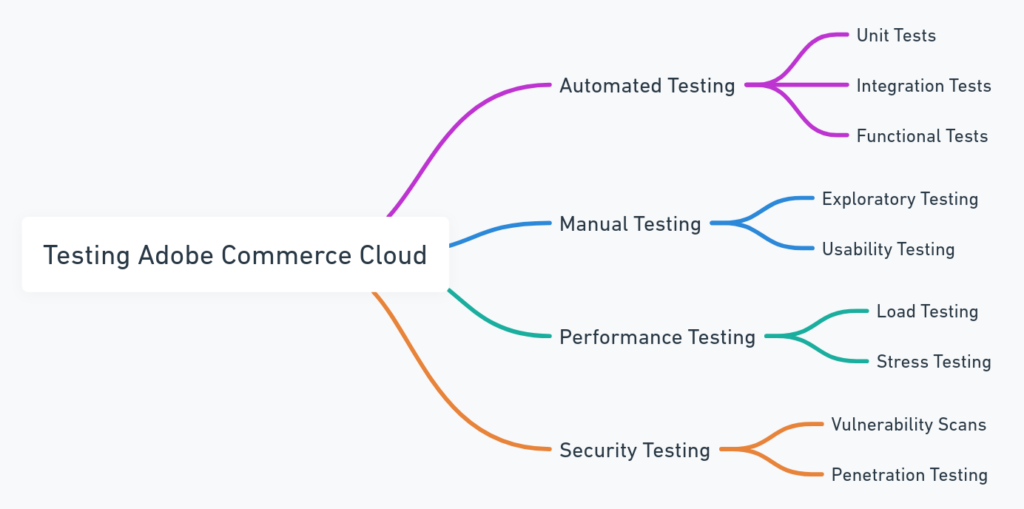Testing Adobe Commerce Cloud, formerly known as Magento Commerce Cloud, is critical to ensure that your e-commerce platform runs smoothly, securely, and efficiently.
This suite of tools is designed to provide robust e-commerce solutions, making it imperative to perform thorough testing to exploit its full potential.
Ensuring reliability, performance, and security through rigorous testing practices helps in crafting a seamless shopping experience for users while minimizing disruptions and maximizing uptime and sales conversion rates.
Understanding the testing essentials can significantly contribute to the operational success of your Adobe Commerce Cloud deployment.
Importance of Testing Adobe Commerce Cloud
Testing Adobe Commerce Cloud is crucial for retailers and businesses that rely on providing a flawless e-commerce experience to their customers.
Proper testing ensures that any digital storefront built with this platform performs optimally across all user touchpoints.
Effectively testing Adobe Commerce Cloud helps businesses to minimize issues that can negatively impact customer interactions, operate more seamlessly, and ultimately drive sales.
Enhancing user experience
User experience (UX) is paramount in e-commerce, where the smallest annoyances can deter potential sales. Testing the user interface and overall user journey ensures that customers find the platform easy to navigate and pleasant to use.
This involves checking that pages load efficiently, links lead to the correct pages, images display properly, and that the checkout process is smooth and intuitive.
Furthermore, testing must ensure that the platform adapts well to different devices and browsers, providing a consistent experience that meets the high expectations of today’s digital shoppers.
Maximizing e-commerce performance
In addition to enhancing the user experience, testing helps to maximize the overall performance of the e-commerce platform. This includes ensuring that the site can handle high traffic volumes, particularly during peak shopping times like Black Friday or Cyber Monday.
Load tests and stress tests are essential to ascertain that the platform remains stable and responsive under various conditions. Moreover, functionality tests help verify that all components of the online store, from product search to payment gateways, work without hitches.
Proper performance testing helps identify bottlenecks and other issues that could slow down the site, thereby preventing potential loss of sales and tarnishing of brand reputation.
Key Strategies for Testing Adobe Commerce Cloud

Developing a comprehensive strategy for testing Adobe Commerce Cloud is essential for ensuring that an e-commerce site meets its performance benchmarks and provides a secure, high-quality user experience.
The following strategies are vital in achieving a robust testing process.
Regression testing
Regression testing is crucial whenever changes are made to the e-commerce platform, such as upgrades or patches to Adobe Commerce Cloud itself or its extensions.
This type of testing ensures that new updates do not disrupt or degrade existing functionalities. Effective regression testing generally involves re-running previous test cases to verify that past features still operate correctly post-update.
Automation tools can be particularly beneficial in this process, allowing frequent and thorough re-testing with minimal effort.
Performance testing
Performance testing is specifically designed to understand how a system operates under a particular load.
This is not only important for ensuring that the website can handle expected traffic but also for predicting system behavior under peak loads. Strategies for effective performance testing include:
- Load testing to measure response times at various traffic points.
- Stress testing to determine the site's breaking point or maximum operational capacity.
- Spike testing to see how the system handles sudden surges in traffic, simulating real-world scenarios like flash sales or marketing campaigns.
Security testing
In the world of e-commerce, security cannot be overstated. Customers entrust personal and financial information to your platform, making it imperative to seal any vulnerabilities.
Security testing should be comprehensive, covering areas such as data protection, risk assessment and vulnerability scanning. Regular security audits and employing penetration testing can help discover weaknesses before they can be exploited.
Additionally, ensuring compliance with standards such as PCI DSS is crucial for maintaining trust and legal compliance.
Through these testing strategies, businesses can ensure that their Adobe Commerce Cloud platform not only meets but exceeds their performance and security expectations.
Best Practices for Testing Adobe Commerce Cloud
Test Automation Tools
Incorporating automation into the testing strategy for Adobe Commerce Cloud significantly enhances efficiency and accuracy. Leveraging test automation tools can help in covering more grounds within shorter periods, especially beneficial for regression, functional, and performance testing.
Tools such as Selenium, TestNG, and JMeter are highly compatible with Adobe Commerce Cloud's environment. Selenium automates browsers, making it perfect for end-to-end testing, while TestNG offers a more versatile testing framework suitable for both unit and functional tests.
JMeter excels in testing application performance and behavior under load. Employing these tools ensures thorough, repeatable testing cycles that are crucial for maintaining the robustness of commerce platforms.
Cross-browser Compatibility Testing
Ensuring that an e-commerce site performs consistently across different browsers is crucial for providing a universally good user experience.
When testing Adobe Commerce Cloud, it's essential to verify that all elements function seamlessly across Chrome, Firefox, Internet Explorer, Safari, and Edge.
Tools like BrowserStack or Sauce Labs offer robust platforms for automating these tests on various browsers and operating systems without the need for multiple physical devices.
This testing ensures that layout, functionality, and performance issues specific to any browser are identified and rectified, facilitating a smooth shopping experience for all users irrespective of their browser choice.
Load Testing
Load testing is indispensable for e-commerce platforms, particularly for assessing how Adobe Commerce Cloud handles high traffic scenarios. It’s crucial to simulate real-world traffic conditions to identify potential bottlenecks and performance thresholds.
Using tools like Apache JMeter or LoadRunner, testers can mimic numerous virtual users interacting with the commerce site to observe performance under stress.
This practice helps in understanding the maximum handling capacity of the site, ensuring that it remains stable and responsive during peak sales periods.
Regular load testing should be a key component of the QA cycle, especially before launching new marketing campaigns that are expected to drive significant traffic.
Book a Demo and experience ContextQA testing tool in action with a complimentary, no-obligation session tailored to your business needs.
Conclusion
Ensuring a seamless e-commerce experience with Adobe Commerce Cloud demands thorough testing and constant monitoring. By focusing on functional testing, performance testing, security compliance, and regular updates, businesses can maximize the reliability and effectiveness of their online platforms.
Remember, the goal is not just to fix what is broken but to proactively enhance the platform for an optimal user experience, driving better engagement and increased sales. Effective testing translates into a trustworthy, efficient, and scalable commerce solution. B
y harnessing the full potential of Adobe Commerce Cloud, businesses are well-equipped to meet the evolving demands of the digital marketplace and deliver exceptional experiences to their customers.
Also Read - Find Usage pattern of your product using tools
We make it easy to get started with the ContextQA tool: Start Free Trial.
